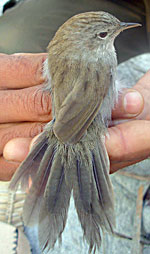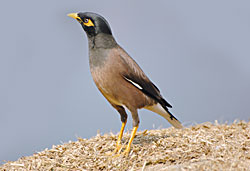October marks the start of the best bird-watching season in Nepal. And what a place to watch: nine per cent of the entire world's bird species are found in this country.
There are 863 species of birds found in Nepal, which is more than can be found on the entire continent of North America. It is Nepal's topographic diversity, ranging from the wetlands of Kosi Tappu barely 90 metres above sea level to Himalayan peaks above 8,000 metres, that provides the diverse habitat to make the rich birdlife possible. The hills around Kathmandu Valley alone is home to more than 500 species of birds.
About 600 of the birds found in Nepal are indigenous and some 150 are migratory species that stop over in Nepal on their east-west or north-south migration from Siberia to Indonesia, Sri Lanka and even Africa. New species are still being spotted, with 13 new species recorded in the past five years.
But not all is rosy in the bird world. "About 80 per cent of the birds in Nepal are threatened because their habitats are being destroyed," says Hem Sagar Baral of Bird Conservation Nepal. Nationally, 134 species of birds have been identified as threatened, including 33 that are globally considered under threat.
The main threats are from human encroachment of forests, filling in of wetlands, river and lake pollution and the use of pesticides in fields. Vultures throughout South Asia, for example, are on the verge of extinction because of the use of steroids to treat livestock. This poisons the birds that feed on carrion.
Although nearly 20 per cent of Nepal's land area is protected, a high proportion for a developing country, critically important areas like Phulchoki, the Dharan forests, Mai Valley and Tamur Valley and their watersheds remain unprotected. Some birds with special habitats?such as the Golden-breasted Fulvetta, which live only in bamboo forests? are now struggling to survive as the bamboo groves are cleared.
As the monsoon clouds clear and the northern winter approaches, keen birders should get out their binoculars and be strategically located to look out for birds heading south.
 ALL OTHER PICS: FRIENDS OF BIRDS |
 |
 |
 |
|
Where to bird-watch
Kosi Tappu Wildlife Reserve
 MIN RATNA BAJRACHARYA |
This island in the Kosi's delta fan as is Nepal's (and Asia's) richest bird sanctuary. Situated in the plains, along a river valley that is the superhighway for trans-Himalayan bird migration, it is a major winter sanctuary for migratory water fowl. More than 485 species have been recorded here, including 20 or so that are globally threatened species.
The Swamp Francolin, Black-bellied Tern, Lesser Adjutant and Yellow-breasted Bunting, which have been listed as vulnerable species globally, are fairly common in the area.
When the Kosi embankment was breached in September, many feared for the rich wildlife that the reserve shelters. So far, the birds are still there, but bird experts say construction work to bring the Kosi back to its original channel could disturb birds this winter.
Chitwan National Park
The Chitwan National Park has a combination of Siwalik hills and pristine tropical forests. Its location on the flood plains of the Gandaki and Rapti rivers makes it an ideal place for bird-watching. There is a combination of indigenous and migratory species, and some 480 species of birds have been identified in Chitwan.
Bardia National Park
With similar terrain to Chitwan, the Bardia National Park is rich in western lowland species. It is also on the migratory routes up and down the Karnali and has many species from western Tibet. There are several resorts that will bring you within binocular distance of Hawk-eagles and Bengal Floricans. Further west is Sukla Phanta, which has hundreds of migratory species wintering in the Mahakali floodplain.
Other national parks
Most birds have migrate down from the high mountain national parks like Langtang, Annapurna, Sagarmatha and Makalu-Barun in winter. So it isn't the best season for bird watching as most birds have already headed down the mountain or flown south. But Alpine Choughs can still be observed soaring up the valley winds and Nepal's national bird, the Danfe, stays behind to forage among the dwarf juniper slopes. There are also plenty of Cakor Partridges, Himalayan Snowcocks, Cheer and Kokla pheasants to be seen.
Kathmandu Valley
 |
One doesn't need to go too far afield for birdwatching. Shivapuri, Pulchoki and Nagarjun are so rich in birdlife that ornithologists come all the way from Europe and the United States to visit the forests on the valley rim.
With its 1,500m vertical altitude range, Phulchoki is a birders' paradise with more than 250 species on just one mountain. Pulchoki's restricted-range species include the Hoary-throated Barwing, and threatened species like the White-rumped Vulture and Slender-billed Vulture.
Across the valley, Shivapuri has seen a remarkable resurgence after being declared a national park and has more than 180 species waiting to be ticked off, including the Spiny Babbler.
Taudaha may just be a pond on the Pharping road, but is a stopover for many migratory birds on their way from the Tiebtan plateau to the Tarai. Local youth have cleaned it up and there are good vantage points from which to watch the waterfowls.
Nepalicola
| |
An important addition to Nepal's huge bird family is a sub-species of the
 BIRD CONSERVATION NEPAL Rufous-vented Prinia |
Other subspecies of Prinia burnesii are already known. Prinia burnesii burnesii is found in parts of Pakistan and adjacent areas of Punjab in India. Prinia burnesii cinerascens is found in Assam. Perhaps it was only a matter of time before one sub-species would also appear in Nepal.
The birds were spotted on patches of grassland on small islands in the Kosi river. Similar grasslands are also present in Chitwan, Bardia and Sukla Phanta, and experts believe that this prinia may be present in those areas as well. Based on the Kosi study and the availability of suitable habitat, it is estimated that the current population of the Rufous-vented Prinia in Nepal could be as large as 500.
In January 2008, another new species? Sykes's Nightjar Caprimulgus mahrattensis? was spotted in the sandy banks of Kosi. This Nightjar breeds in Pakistan and North West India and flies to the south of centre China in winter. However, this is the first time that the bird has been seen in Nepal. Experts believe that this species is simply a visitor bird and that its population is probably low. This new discovery has increased the number of species of Nightjars recorded in Nepal to five.
Flying high
|
Bird migration routes are older than the Himalayas. As the mountains rose, birds adapted to flying higher and higher.
 WILDLIFE INSTITUTE OF INDIA/ US FISH AND WILDLIFE SERVICE |
Satellites have tracked a wired bar-headed goose's flight path as it took off from the Bharatpur bird sanctuary in north India, across western Nepal up to the Tibetan plateau, crossing three countries. The bird rode the jetstream, flying over 500km at an altitude of 5,000m in 16 hours and 30 minutes to lakes north of Mustang in Tibet.




